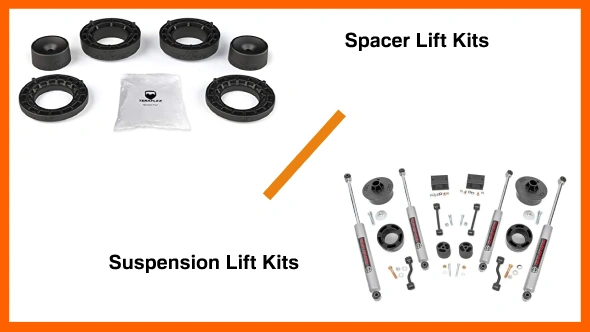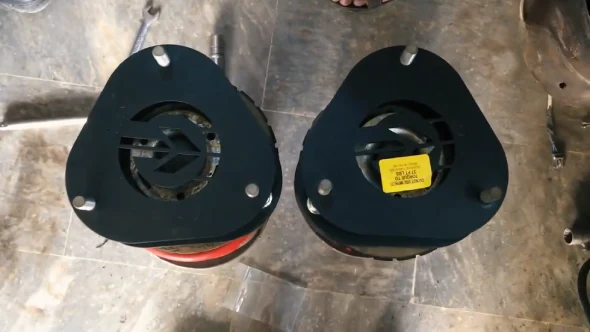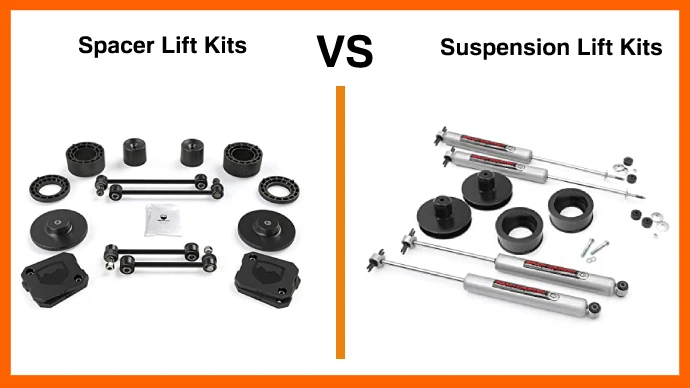Last Updated on April 5, 2023
Upgrading your Jeep, truck, or SUV with a spacer lift or suspension lift is an excellent way to increase its performance and give it a unique look.
But how do you decide which one is right for you? Spacer lift kits and suspension lift kits both raise the vehicle, but they do so in different ways that will affect the outcome of each installation.
Spacers are generally easier to install and less expensive than suspension lifts because they require fewer components. On the other hand, suspension kits offer more lift height but may cause a rougher ride.
Let’s take a closer look at the differences between spacers and suspension lifts so that you can pick the right one.
Spacer Lift Vs Suspension Lift: Unveiling the Contrast

Ready to lift your ride? You’ve got two options: spacer lifts and suspension kits. While both can give you a boost in height, some key distinctions might impact your choice. It’s time to examine the differences between these two types of vehicle-elevating solutions.
1. Components
Spacer lift kits use existing factory or aftermarket coil springs and struts, while suspension lift kits are a much more complex system.
Suspension lifts come with additional components such as springs, shock absorbers, and control arms. These components serve to provide additional support for the vehicle, allowing it to raise its total height by several inches.
2. Installation
Installing a spacer lift kit is typically less complicated than installing a suspension lift kit. With a spacer kit, you’ll just need to place the included spacers on top of your existing factory coil spring assemblies or strut units.
On the other hand, installing a suspension lift requires replacing the original suspension system with new components like shocks, springs, and control arms.
This process is much more complex than installation with just plain spacers, requiring lifting the vehicle off the ground for proper installation and making sure all parts line up correctly.
3. Cost
The cost of a spacer lift kit is generally lower than that of a suspension lift kit because it requires fewer components.
This is because spacer lift kits rely on existing components, such as shocks and struts, and only add additional spacers to lift the vehicle.
In contrast, suspension lift kits require more parts due to replacing the factory components with aftermarket ones. These kits tend to be more expensive due to the cost of buying aftermarket parts and the labor involved in installing them.
4. Lift Height
Spacer lift kits are usually limited to providing a lift height of 1″ to 2.75″, whereas suspension lifts can offer up to 3″ to 6″ of height increase.
The reason for this difference is that spacer lifts rely on existing factory parts, which are not designed for greater heights than what is offered by these kits.
Suspension lifts provide greater increases in height because they replace the stock parts with aftermarket ones that allow for a higher capacity of lifting.
5. Ride Quality
Spacer lifts retain the factory coil springs and struts. This means that, when installed correctly, they will maintain a very similar ride quality as stock vehicles have.
On the other hand, suspension lift kits may cause some changes in ride quality. Since they involve replacing certain factory components with aftermarket ones that might not provide the same ride characteristics as those included in the original setup by automakers.
6. Ground Clearance
Suspension lift kits provide increased ground clearance by raising the entire vehicle off of the ground.
The added clearance between your vehicle and the surface below gives you extra clearance for obstacles such as rocks or logs when off-roading or rock crawling.
On the other hand, spacer lift kits only increase ground clearance by adding strut spacers between existing components, such as strut towers or leaf springs.
This type of lift does not provide more space between the underside of your vehicle and the ground beneath it as a suspension lift would.
7. Gas Mileage
When comparing spacer lift vs. suspension lift, the difference in gas mileage is notable. Spacer lifts typically result in less of a reduction in gas mileage than suspension lifts due to the shallower lift height.
Suspension lifts are more drastic and have a greater impact on gas mileage, as they involve increasing the height of the vehicle more drastically. This increases surface area for wind resistance, resulting in decreased fuel economy.
However, some suspension kits also come with features that can improve aerodynamics and reduce drag on the vehicle, and these features can help offset some of the negative effects on fuel economy.
8. Compatibility
When considering compatibility, it’s important to note that not all vehicles are compatible with both types of lifts.
Spacer lifts typically work with most kinds of suspension systems, but suspension lifts often require specific vehicle models and suspension configurations for proper installation.
Therefore, it’s important to research your vehicle before purchasing either type of kit in order to guarantee compatibility and successful installation.
9. Durability
When it comes to durability, there’s a clear distinction between spacer lifts and suspension lifts. Generally, suspension kits tend to be much more durable than spacer lifts because they are designed to handle higher stress levels due to their greater increase in height from the ground.
Conversely, strut spacer lifts may wear out faster due to their lack of added support or fail under heavy use such as off-roading.
It’s worth noting that proper installation is key when it comes to both types of kits. If either isn’t installed correctly, it could cause issues with performance or even safety down the line.
10. Off-Road Performance
Regarding off-road performance, a suspension lift kit is usually the better choice due to its enhanced stability and handling on rough terrain.
Suspension lifts are built for rough off-roading, providing improved traction control, articulation, suspension travel, and ground clearance for tackling tough obstacles.
Spacer lifts may be unable to provide this performance level due to their limited clearance and change in center of gravity.
11. Tire Size
Suspension lifts generally allow for larger tires than spacer lifts, as they provide extra clearance. This is because a suspension lift kit changes the vehicle’s frame height and allows for larger tires without compromising on ground clearance.
If you want to run bigger tires without compromising on your vehicle’s ride height or quality of ride, then you should look into getting a suspension lift kit.
12. Maintenance
Regarding maintenance requirements, spacer lifts tend to require less work than suspension lifts due to their simple construction and lack of additional components.
Spacer kits can often be removed and reinstalled without having any major impact on performance or reliability. This makes them a great option for those who don’t want to spend too much time doing maintenance or upgrading parts every few months.
Suspension lifts have more complex components that need regular checking and maintenance to ensure they continue functioning properly.
This can include replacing shocks, bushings, and other parts as needed for the lift kit’s performance not to be compromised by deterioration over time.
Depending on how frequently you use your vehicle off-road or on rough terrain may dictate how often these components need replacement as well as how extensive the job may become.
13. Ride Height Adjustability
Spacer lift kits don’t offer much adjustability regarding ride height since they only add a fixed amount of lift. Suspension lifts can provide greater adjustability for ride height, allowing you to fine-tune the look and feel of your vehicle for optimum performance and style.
You can raise or lower the ride height with a quality suspension lift kit, depending on your needs and preferences. It’s an excellent choice for anyone looking for a versatile lifting solution.
Can You Put a Spacer Lift on a Suspension Lift?

It is possible to attach a spacer lift to a suspension lift, but it is not recommended. This is because the additional height can create a lot of stress on the vehicle’s suspension components, such as ball joints, tie rod ends, and CV joints.
The extra stress can lead to premature wear and damage, which can be costly to repair. Also, adding a spacer lift could alter the vehicle’s geometry, impacting its ride quality.
If you are looking to lift your vehicle no more than 3 inches, then it likely won’t need to be paired with a spacer.
In any case, if you do decide to use one, then it’s important that you make sure it is only equivalent to the remaining geometry of the arm. This will help ensure that your vehicle remains safe while also providing you with an improved look.
Although it may be tempting to add a spacer lift on top of your suspension lift, there are risks associated with doing so that should be considered before making any decisions.
In some situations, it may be necessary, but in most cases avoiding this combination entirely would be best for both your wallet and your car’s overall health.
How Big of a Spacer Is Safe to Run?
Spacers are available in different sizes depending on the make and model of your vehicle. Generally, for most vehicles, 25mm spacers are safe to use since they have been used for decades without any major issues.
If you have a modified or lifted car with larger tires, it is important to consider running bigger spacers that are up to 30mm in size. This is because wider wheels and tires can rub against the fenders or suspension components if they don’t have enough clearance.
Do Spacers Cause Wobble?

Wheel spacers can cause wobble, but only if they are not installed properly. It is important to use the correct tools and materials when installing wheel spacers so that they fit securely and align with the wheels in order to avoid any misalignments.
When a wheel spacer is misaligned, it puts extra stress on the lug nuts, causing them to loosen or become misaligned, which can lead to vibration and wobble. It is also important to pay attention to the quality of the material used for the spacers.
Higher quality materials will be able to better withstand extreme temperature changes, bumps, and shocks from off-road driving conditions. Properly installed spacer lifts will not cause any vibration or wobble whatsoever.
Space vs. Suspension: Pick the Right Kit
Deciding between a spacer lift kit and a suspension lift kit can seem daunting, but if you have the right information, making an informed decision can be much simpler.
Spacers are easy to install and cost-effective compared to suspension lifts. But they offer less lift height than suspensions. Suspension kits provide higher levels of lift height but may change your vehicle’s ride quality.
Ultimately, it comes down to your budget, desired outcome, and purpose of installation when choosing between these two products.

